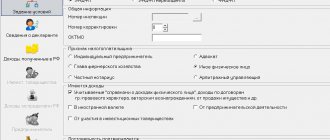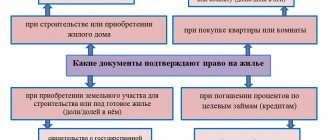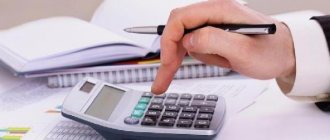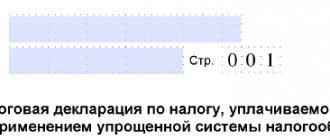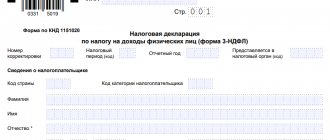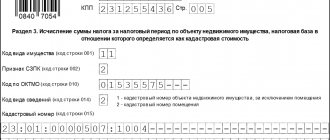Appearance and structure
To give a specific completed example of Sheet E1 from 3-NDFL, you need to understand the form in which this declaration is submitted.
So, for 2021, individuals who want to return personal income tax on their own (for example, it is not possible to do this through a tax agent, since the person no longer works for him), do this on the 3-NDFL declaration form, approved by order of the Tax Service of Russia dated December 24 2014 No. ММВ-7-11/671.
Also see “Download the 3-NDFL declaration for 2021 to fill out.”
The E1 Sheet in question looks like this:
This form was last updated on October 10, 2021. At the same time, they affected Sheet E1 of the 3-NDFL declaration for 2021. Thus, in field 030, the income limit giving the right to a “children’s” deduction has increased since 2016 to 350,000 rubles (Federal Law No. 317-FZ dated November 23, 2015).
Also see “3-NDFL in 2021: what has changed.”
As you can see, any example of filling out Sheet E1 of the 3-NDFL declaration always takes one standard A4 sheet of this form.
In its structure, any example of Sheet E1 of the 3-NDFL declaration includes 4 points:
- Calculation of standard deductions.
- Calculation of social deductions for which there is no limit of 120,000 rubles.
- Calculation of social deductions, for which there is a limit of 120,000 rubles.
- Their total amount.
You will immediately notice when filling out 3-NDFL that in the sample Sheet E1 almost every line is a separate deduction. That is, any complex calculations or comparisons are not initially provided.
When entering indicators into Sheet E1, it is difficult to imagine that all its lines will be filled in. Therefore, dashes must be placed in unused places. This will be clearly demonstrated by our example of filling out Sheet E1 of the 3-NDFL declaration in 2021 (see below).
In addition, unlike income tax amounts, deductions in 3-NDFL are given with kopecks or zeros in their place.
Form 3-NDFL for tax deduction in 2020: where and how to fill out
The items “Series and number”, “Date of issue”, “Issued by” are filled out strictly according to the identity document. In “Taxpayer Status,” number 1 means a tax resident of the Russian Federation, 2 means a non-resident of Russia (who lived less than 183 days in the Russian Federation in the year of income declaration).
We recommend reading: List of items of property that cannot be withdrawn from the debtor
On the title page, indicate the total number of completed pages and the number of attachments - supporting documents or their copies. In the lower left part of the first page, the taxpayer (number 1) or his representative (number 2) signs the document and indicates the date of signing. The representative must attach a copy of the document confirming his authority to the declaration.
Our sample of Sheet E1 of the 3-NDFL declaration
As a general rule, the right to a standard and/or social deduction depends on the current life situation. Therefore, it is impossible to give an example of filling out Sheet E1 3-NDFL for 2021, covering all bases under the Tax Code of the Russian Federation.
We proceeded from the most common situation: when a mother has a child under 24 years of age and pays for his full-time education at a university at her own expense.
Also see “Who must submit 3-NDFL for 2021: list and new rules.”
EXAMPLE
Let us agree that E.A. Shirokova paid for her son’s university studies in 2021. The total amount was 100,000 rubles. According to a certificate from the educational institution, her son is in full-time education.
Shirokova’s labor and other income, taxed at a rate of 13%, amounted to 600,000 rubles in 2016. In 2021, she decided to return personal income tax in connection with her son’s education.
The maximum social deduction for tuition fees that can be declared in 3-NDFL is 50,000 rubles (page 100 of Sheet E1) based on clause. 2 p. 1 art. 219 of the Tax Code of the Russian Federation.
Shirokova’s son is not yet 24 years old, and he is studying full-time. Therefore, while she was working, every month in 2021 she received a standard deduction for it (1,400 rubles each). Namely: for 7 months, until her income approached the mark of 350,000 rubles (subclause 4, clause 1, article 218 of the Tax Code of the Russian Federation).
The indicator for lines 040 and 080 is obtained as follows:
1400 rub. × 7 months = 9800 rub.
Below is a sample of filling out Sheet E1 from 3-NDFL for 2021, which E.A. Shirokova submitted on March 2, 2021 to the Federal Tax Service No. 18 of Moscow:
As you can see, in Sheet E1, based on the results of calculations, they show the total amount of deductions: standard + social. Even if the “children’s” deductions were provided by the employer.
Now let’s find out what amount of personal income tax Shirokova will ultimately return from the treasury if she fills out Sheet E1 of the 3-NDFL declaration for 2016.
We reduce the total income by all the deductions required by Shirokova:
600,000 rub. – 59,800 rub. = 540,200 rub.
RUB 540,200 ×13% = 70,226 rub. (calculated personal income tax taking into account deductions for training).
However, the employer provided Shirokova only with a “children’s” deduction. That is, the withheld tax was greater:
(RUR 600,000 – RUR 9,800) × 13% = RUR 76,726
As a result, in 2021, according to the 3-NDFL declaration, Shirokova will be able to return:
RUR 76,726 – 70,226 rub. = 6500 rub.
Also see “Sheet E1 of the 3-NDFL declaration for 2021: filling out.”
Read also
03.03.2017
Samples of completed declaration sheets
To understand which sheet of the tax return form needs to be filled out to calculate a certain type of deduction, just read the names of all the pages (they are highlighted in bold) and select the one you need.
Thus, if an individual wants to apply for social tax compensation, then he needs to fill out sheet E1. The same page is also intended for receiving a standard deduction. And if the taxpayer sold or bought property and wants to return income tax, then sheet D2 or D1, respectively.
If we are talking about calculating compensation for costs associated with medical services, and the applicant for the deduction has already completed the main pages of 3-NDFL, then he just needs to indicate the information in a few lines of sheet E1:
- 080 – in this field you must write the amount of the standard tax rebate accrued to the applicant (sheet E1 is simultaneously devoted to the registration of both social and standard deductions). Since the example under consideration relates only to the return of personal income tax for treatment, a zero must be entered in this field;
- 110 – if the taxpayer spent material resources on medical services that are recorded in the list of expensive procedures approved by law, then this line must display the amount of the amount spent;
- 120 – next to this code you must re-enter the amount from the previous paragraph. This field is intended to indicate the total amount of social expenses that went to charity, education and health services. Since this example focuses only on deductions for treatment, the same values are entered in lines 120 and 110;
- 140 – if, in addition to expensive services, the taxpayer paid for standard medical procedures or spent money on the purchase of medicines, then such costs must be recorded in this line of the third paragraph of sheet E1;
- 170 – the same numbers are written here as in line with code 140, since the applicant for the social tax rebate did not incur costs for his education or the education of brothers/sisters, and also did not spend money on pension or insurance payments;
- 180 – this field is required to enter the total amount that comes out as a result of adding up the amounts of all social expenses declared in the 3-NDFL form. In this case, you need to sum the values from lines 120 and 170;
- 190 - this line implies an indication of the total amount of two types of tax deductions (standard and social). Since the size of the first of them is zero, the parameter entered in the previous paragraph of page E1 is written again in this field.
If a taxpayer, who was the legal owner of real estate in the past, sold it and wants to receive tax compensation, he will need to enter certain information on the sheet of the D2 declaration form. We recommend that you start filling out any page by putting down the numbers of the identification code of the applicant for a reduction in the tax base, indicating the sheet number and writing the surname and initials.
After this, the taxpayer, regardless of the monetary limits in which he applies for a tax discount on the property, will need to display the total amount of profit that he received during the tax period from all available sources of payment. And then enter the following parameters:
- The deduction amount. In sheet D2, many fields are intended for writing the amount of the tax discount. However, each of them corresponds to a separate situation. For example, line 040 is intended for individuals who sold a share in a property and want to receive tax compensation. Lines 080 and 120 are for deductions, the maximum amount of which is 250,000 rubles.
- Amount of expenses. Also on sheet D2 there are fields in which you must enter the amount of the taxpayer’s expenses, confirmed with the help of documentation. This value must be indicated in line 060, 100 or 140. The choice of field depends on the size of the cost.
- Total amount. Taking a visual approach to sheet D2, any taxpayer will notice that it is divided into two columns. In line 210 you need to write the result that will come out after summing up all the parameters displayed by the applicant for a property deduction in the second column.
After the applicant for the deduction accrued for the sale of real estate decides which of the above parameters he needs to indicate and enters them into sheet D2 of form 3-NDFL, he will need to confirm their accuracy - sign at the bottom of the page and write the date next to it.
As a rule, document verification takes from 30 to 120 days. After this period, the money is transferred to the applicant’s bank card for income tax refund. And in case of an unfavorable outcome of this procedure, the individual is sent a written refusal to accrue a tax discount.
Declaration 3 of personal income tax is submitted in KND form 1151020 using a new salary certificate for 2021. Individuals who previously changed their place of work will have to re-order a document for deduction.
1. Title page - indicates the series, passport number and special encodings:
- taxable period;
- tax authority;
- a country;
- identification document;
- belonging to the Russian Federation.
2. Pages 1 and 2 are based on final counts.
3. Income in increments:
- in Russian organizations – No. 1;
- outside the Russian Federation – No. 2;
- for those engaged in private practice, entrepreneurs and lawyers – No. 3.
4. Sheet 4 – in the presence of non-taxable financial resources.
The justification for accepting the declaration is also a statement from the taxpayer. To transfer money, you will need to fill out bank account details and information about the individual. At the end, all pages are counted and their number is indicated.
Which sheets should be filled out and when?
The tax return type KND 1151020 has nineteen sheets, and the Federal Tax Service website provides detailed instructions for filling out each one. We present the statements most commonly used by taxpayers:
This is an article from the site vseofinansah dot ru. If you are posting this article on another site, then it has been stolen.
Sheet A – allows you to indicate information about the sold apartment or car.
- Sheet E1 - to indicate the social deduction for personal income tax for the treatment and education of the child. You will also need information from sheet A here.
- Sheet D1 - is filled out for property deduction; if the apartment is sold, you also need to fill out sheet D3 and two sections Nos. 1-2.
We invite you to familiarize yourself with the Unified Agricultural Tax | Federal Tax Service of Russia | 77 Moscow city
Section 1:
Section 2:
- Sheet D2 - filled out when selling an apartment that has been owned for less than 3 years and to obtain a tax deduction for this housing.
Sheet D2:
Tax return in form 3-NDFL
- Purchased real estate;
- Registration of a mortgage;
- Payment for education for yourself, children or close relatives;
- Paid medical care;
- Voluntary pension contributions;
- Opening an individual investment account;
- Deductions to charity.
- declaration and print it out (or get it from the tax office), and then fill it out manually.
- Fill out the 3-NDFL declaration form on the computer.
- Fill out the declaration using the “Declaration” program, which can be downloaded from the tax website.
